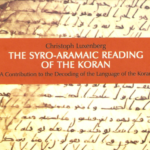
The author of the book The Syro-Aramaic Reading of the Koran affirms that he put aside all the previous theories put forward by Orientalists or Arab scholars and their many attempts to interpret the Qur’ān – from his starting point that the Arabic of Sibawayh’s Arabic grammar and onwards was not the Arabic of the Qur’ān. He based this on linguistic analysis that confined the reading and understanding of the Text to its specific time frame and free of subsequent influences.
BY KAMIL ALI
BECAUSE THE COMMENTATORS relied on subsequent oral transmission without taking into consideration the language in its historical framework, they fell into error with the result that ‘ambiguous passages’ were left unexplained. There are also other texts in the Qur’ān whose meaning in Arabic has yet to be challenged to date, while research shows that they should be re-read in the light of objective linguistic analysis. In pursuing such a research, Christoph Luxenberg adopted a methodology that may be summarized as consisting of five steps:
- As a first step Luxenberg reviews the interpretation of al-Ṭabarī in recognition of the fact that the Islamic tradition may preserve a correct interpretation – when not countered by the commentators – supported by linguistic evidence. If this is not the case, as a second step, he resorts to the encyclopedic Lisān al-‘Arab dictionary by Ibn Manẓūr (1232-1311 AD) in the hope of finding the appropriate explanation, especially since al-Ṭabarī did not refer in his commentary to any Arabic dictionary and based himself on oral transmission alone. The latter did, however, in some cases cite Arabic poetry (despite its distance from the language of the Qur’ān) and this investigation often leads to positive results;
- Failing this, Luxenberg reads the Qur’anic text via a Syriac-based reading, and in a number of cases this provides a logical meaning to the passage;
- If this fails, Luxenberg first attempts to alter the diacritical dots around the letters that may have been placed there through lack of familiarity on the part of the Arab editor with the concept of the Qur’ānic text in his Arabic reading. In quite a few cases, this step has yielded positive results;
- When this is unproductive, the researcher embarked on a second exercise in altering the diacritical dots of the letters in order to find a Syriac source-word for the reading; this attempt has led in many cases to a reading that restores the text to its true meaning;
- If all these attempts fail and the Arab writing and reading of the passage is not in doubt, yet fails to yield an appropriate meaning to the text, the researcher then resorts to a more extreme attempt to translate the Arabic expression into Syriac in order to determine what is meant via the use of Syriac homonyms. Research shows that this step goes beyond the previous four steps in importance, since the Syriac expression often lends the ambiguous Arabic Qur’ānic text a clear and logical meaning.
In his detailed application of this linguistic methodology, Luxenberg focuses on some Qur’ānic expressions and verses, relying consistently on scholarly authorities, whether Arabic or Syriac. We present here a simplified model for each of the above steps:
One of the explicit verses unquestioned to this day is verse 64 of Sūrat Al-Isrā’. The subject of this verse is that the Almighty expelled Iblīs from Paradise because he refused to prostrate to Adam, so Iblīs asked permission from Him to allow him to tempt people until the Day of Judgment. The Almighty duly allowed him and followed this with these words:
And startle whomsoever of them you can with your voice, and collect against them your mounted forces or your footsoldiers, and take part with them in their wealth and children, and hold out promises to them; Satan only makes promises to them to deceive.[1]
Al-Ṭabarī explained this verse as the following:
And startle – that is, terrify them by your voice, although this concept contradicts the Qur’ānic understanding that Iblīs whispers into the hearts of men [Qur’ān CXIV (al-Nās), 5].
Luxenberg points out that Lisān al-‘Arab explains and startle in the sense of ‘plunging’ someone into misfortune through cunning, which is the correct understanding of this expression and accords with the Qur’ānic concept.
Al-Ṭabarī explained and startle them with your mounted forces or your footsoldiers as ‘attack people noisily with cavalry and foot-soldiers so as to intimidate them’, but that this concept also contradicts the Qur’ānic meaning. Luxenberg reads ajlib (‘collect against’) as akhlub (‘outwit’), reading the j in ajlib ( ج ) as ( خ) by placing the dot above the letter to give the sense of ‘outwit’ or ‘cheat’ them.
And since it is difficult to ‘outwit’ people by attacking them with cavalry and commotion, Luxenberg believes that it is more appropriate to read the phrase bi-khaylika (‘with your mounted forces’) as bi-ḥiyalika (‘with your snares’) – reading the letter kh ( خ ) as ḥ ( ح ) – and to re-read the letter r ( ر ) in wa-rajilika (‘your footsoldiers’) as d ( د ) wa-dajalika (‘your deceitfulness’),[2] to give: outwit them with your snares and your deceitfulness, something which would be more consistent with the Qur’ān’s intended logic.

Suggested Reading
As for and take part with them in their wealth and children the commentators were amazed at the Almighty’s allowing the devil to take part in people’s wealth and children, given that it is God Almighty who provides them with these things. Al-Ṭabarī attempts to resolve this by explaining this passage as the devil taking part with people in their illicit wealth and in the children as the progeny of adultery. Luxenberg, however, indicates that the original source of the term wa-shārikhum (‘and take part with them’) is from the Syriac root ܣܪܟ srk ‘to trick’, preserved in the Arabic form sharak (‘trick’, ‘snare’) to give the meaning as ‘tempt’, ‘seduce’. This gives the full phrase as: and tempt them with [the promise of] wealth and children. As linguistic evidence for this Luxenberg cites the hadith that runs:
I seek refuge in You from the evil of Satan and his snare (shrkh)[3]
The Qur’ānic meaning intended here is that Satan tempts people by his false promises to them with money and children, and not by sharing or participating with them. This meaning is clear from the end of the verse:
Satan only makes promises to them to deceive.[4]This verse alone gives five typical examples points 1), 2) and 3) of Luxenberg’s methodology mentioned above.
[1] Qur’ān XVII (al-Isrā’), 64.
[2] Luxenberg also suggests a link here with the Syriac term ܕܘܓܠܐ duggālā. (Ed.)
[3] Ṣaḥīḥ al-Tirmidhī, 3/142 . The sunnah.com translation of this hadith mistranslates the last word shrkh as ‘helpers’.
[4] See Christoph Luxenberg, The Syro-Aramaic Reading of the Koran, A Contribution to the Decoding of the Language of the Koran, pp.242-245. See this work in the Almuslih Library here.
Main image: ‘Satan whispering into the hearts of men’ as a theme for contemporary tattooing.
Read Part One of this essay here
